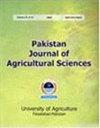棉花品种抗旱遗传变异研究
IF 0.6
4区 农林科学
Q3 AGRICULTURE, MULTIDISCIPLINARY
引用次数: 1
摘要
干旱是一种主要的非生物胁迫,严重降低了棉花产量。因此,抗旱性是一个复杂的现象,它包括形态和生理参数的组合,从而提高棉花的抗旱性。因此,在本研究中,通过在正常水分和有限水分两种水分条件下种植,对150种棉花基因型的抗旱性进行了评估。记录形态和生理参数的数据,即根鲜长(FRL)、地上部鲜长(FSL)、侧根数(LRN)、根鲜重(FRW)、地部鲜重(FSW)、干重(DSW)、重长比(W)、根干重(DRW)、植株重(PW)、,苗期冠层温度(CT)、水势(WP)、渗透势(OP)和相对含水量(RWC)。正常水分条件下幼苗的主成分分析(PCA)解释了PCA1和PCA2总方差的35.21%和15.25%。形态生理参数的记录数据的聚类分析将150种基因型分为六个聚类。第一个聚类包含16个棉花基因型,第二个聚类包含44个,第3、4、5和6个聚类分别包含22、52、10和6个基因型。在水分胁迫条件下,PCA1含有18种棉花基因型,第二个簇含有32种棉花基因,簇3、4、5和6分别含有14、35、30和21种基因型。利用与抗旱性相关的形态生理幼苗性状可以促进育种策略,从而在不断变化的气候条件下进化出对干旱胁迫具有耐受性的棉花基因型。在控制温室条件下筛选耐旱的可用棉花基因型可以缩短筛选时间,提高筛选效率。本文章由计算机程序翻译,如有差异,请以英文原文为准。
Genetic variability in diverse cotton germplasm for drought tolerance
Drought is one of the major abiotic stresses that significantly reduces seed cotton yield worldwide. Therefore, Drought tolerance is a complex phenomenon that comprises a combination of morphological and physiological parameters which results in the enhancement of drought tolerance in cotton. Therefore, in the present study 150 cotton genotypes were evaluated for drought tolerance by planting at two water regimes i.e., normal water and limited water conditions. Data were recorded for morphological and physiological parameters i.e. root fresh length (FRL), shoot fresh length (FSL), lateral root numbers (LRN), root fresh weight (FRW), shoot fresh weight (FSW), shoot dry weight (DSW), weight /length ratio(W), root dry weight (DRW), plant weight (PW), the difference in shoot fresh weight and shoot dry weight (SDWR), stomatal conductance (SC), canopy temperature (CT), water potential (WP), osmotic potential (OP) and relative water contents (RWC) at the seedling stage. Principal component analysis (PCA) of seedling at normal water conditions explained PCA1 35.21% and PCA2 15.25% of the total variance. The cluster analysis of the recorded data for the morpho-physiological parameters grouped 150 genotypes into six clusters. First Cluster included 16 cotton genotypes, 2nd cluster having 44, clusters 3, 4, 5, and 6 contains 22, 52, 10, and 6 genotypes respectively. In water stress conditions PCA1 containing 18 cotton genotypes, 2nd cluster having of 32 cotton genotypes, clusters 3, 4, 5, and 6 contain 14, 35, 30, and 21 genotypes, respectively. The use of morpho-physiological seedling traits associated with drought resistance can facilitate breeding strategies to evolve cotton genotypes having tolerance against drought stress in the changing climatic conditions. Screening of available cotton genotypes for drought tolerance in controlled greenhouse conditions can shorten the duration with improvement in efficiency for screening.
求助全文
通过发布文献求助,成功后即可免费获取论文全文。
去求助
来源期刊

Pakistan Journal of Agricultural Sciences
AGRICULTURE, MULTIDISCIPLINARY-
CiteScore
1.80
自引率
25.00%
发文量
18
审稿时长
6-12 weeks
期刊介绍:
Pakistan Journal of Agricultural Sciences is published in English four times a year. The journal publishes original articles on all aspects of agriculture and allied fields.
 求助内容:
求助内容: 应助结果提醒方式:
应助结果提醒方式:


